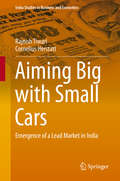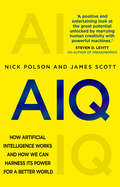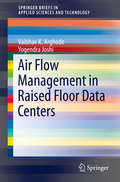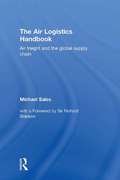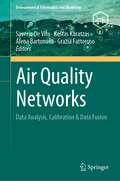- Table View
- List View
Aiming Big with Small Cars: Emergence of a Lead Market in India (India Studies in Business and Economics)
by Rajnish Tiwari Cornelius HerstattThis book focuses on the small car segment of India's automotive industry to explain the emergence of lead markets. The authors contend that the current understanding of lead markets does not sufficiently explain the business practices that are born out of the intensified globalization of innovation. Lead markets are considered crucial for the global diffusion of new products and this book investigates whether sustainable lead markets can also emerge in developing economies, and if so, under which conditions. The authors question the conventional wisdom and propose updates and extensions to the lead market theory to better reflect the changing ground realities on ground.
Aiming for an A in A-level Business
by Phil WaterhouseExam Board: AQA, Edexcel, OCR, WJEC/Eduqas Level: A-level Subject: Business First teaching: September 2015 First exams: Summer 2017Master the skills you need to set yourself apart and hit the highest grades; this year-round course companion develops the higher-order thinking skills that top-achieving students possess, providing step-by-step guidance, examples and tips for getting an A grade.Written by experienced author and teacher Phil Waterhouse, Aiming for an A in A-level Business:Helps you develop the 'A grade skills' of analysis, evaluation, creation and applicationTakes you step by step through specific skills you need to master in A-level Business, so you can apply these skills and approach each exam question as an A/A* candidateClearly shows how to move up the grades with sample responses annotated to highlight the key features of A/A* answersHelps you practise to achieve the levels expected of top-performing students, using in-class or homework activities and further reading tasks that stretch towards university-level studyPerfects exam technique through practical tips and examples of common pitfalls to avoid Cultivates effective revision habits for success, with tips and strategies for producing and using revision resources Supports all exam boards, outlining the Assessment Objectives for reaching the higher levels under the AQA, Edexcel, OCR and WJEC/Eduqas specifications.
Aiming for an A in A-level Economics
by James PowellMaster the skills you need to set yourself apart and hit the highest grades; this year-round course companion develops the higher-order thinking skills that top-achieving students possess, providing step-by-step guidance, examples and tips for getting an A grade. Written by experienced author and teacher James Powell, Aiming for an A in A-level Economics: - Helps you develop the 'A grade skills' of analysis, evaluation, creation and application - Takes you step by step through specific skills you need to master in A-level Economics, so you can apply these skills and approach each exam question as an A/A* candidate - Clearly shows how to move up the grades with sample responses annotated to highlight the key features of A/A* answers - Helps you practise to achieve the levels expected of top-performing students, using in-class or homework activities and further reading tasks that stretch towards university-level study - Perfects exam technique through practical tips and examples of common pitfalls to avoid - Cultivates effective revision habits for success, with tips and strategies for producing and using revision resources Supports the major exam boards, outlining the Assessment Objectives for reaching the higher levels under the AQA, Edexcel and OCR specifications.
Aiming for an A in A-level Economics
by James PowellExam Board: AQA, Edexcel, OCRLevel: A-levelSubject: EconomicsFirst teaching: September 2015First exams: Summer 2017Master the skills you need to set yourself apart and hit the highest grades; this year-round course companion develops the higher-order thinking skills that top-achieving students possess, providing step-by-step guidance, examples and tips for getting an A grade.Written by experienced author and teacher James Powell, Aiming for an A in A-level Economics:- Helps you develop the 'A grade skills' of analysis, evaluation, creation and application- Takes you step by step through specific skills you need to master in A-level Economics, so you can apply these skills and approach each exam question as an A/A* candidate- Clearly shows how to move up the grades with sample responses annotated to highlight the key features of A/A* answers- Helps you practise to achieve the levels expected of top-performing students, using in-class or homework activities and further reading tasks that stretch towards university-level study- Perfects exam technique through practical tips and examples of common pitfalls to avoid - Cultivates effective revision habits for success, with tips and strategies for producing and using revision resourcesSupports the major exam boards, outlining the Assessment Objectives for reaching the higher levels under the AQA, Edexcel and OCR specifications.
Aiming for Global Accounting Standards: The International Accounting Standards Board, 2001-2011
by Stephen A. Zeff Kees CamffermanThe International Accounting Standards Board (IASB) and its International Financial Reporting Standards (IFRSs), have acquired a central position in the practice and regulation of financial reporting around the world. As a unique instance of a private-sector body setting standards with legal force in many jurisdictions, the IASB's rise to prominence has been accompanied by vivid political debates about its governance and accountability. Similarly, the IASB's often innovative attempts to change the face of financial reporting have made it the centre of numerous controversies. This book traces the history of the IASB from its foundation as successor to the International Accounting Standards Committee (IASC), and discusses its operation, changing membership and leadership, the development of its standards, and their reception in jurisdictions around the world. The book gives particular attention to the IASB's relationships with the European Union, the United States, and Japan, as well as to the impact of the financial crisis on the IASB's work. By its in-depth coverage of the history of the IASB, the book provides essential background information that will enrich the perspective of everyone who has to deal with IFRSs or the IASB at a technical or policy-making level.
Aiming High: Masayoshi Son, SoftBank, and Disrupting Silicon Valley
by Atsuo Inoue__________*Picked by the Financial Times as a Best Read of 2021*'I have no intention of making small bets' - Masayoshi SonIn order to understand what's happening in Silicon Valley, you just need to look at Masayoshi Son. __________There is no one in the world right now who is in a better position to influence the next wave of technology than Masayoshi Son. Not Jeff Bezos, not Mark Zuckerberg, not Elon Musk. They might have the money, but they lack Masa's combination of ambition, imagination, and nerve. Masayoshi Son is the most powerful person in Silicon Valley. As CEO and founder of the Japanese investment firm, SoftBank Group, 'Masa' has invested in some of the most exciting and influential tech companies in recent memory - Uber, WeWork, ByteDance, and many others. Prior to that, he was known as one of the first investors in Alibaba and Yahoo!He has an audacious vision for the future and one that is unmatched in the tech industry. Aiming High provides insight into this charismatic and visionary leader. Originally published in Japan, this book charts Son's rise from a Korean immigrant who left Japan at 16 to becoming one of the wealthiest people in the world. With unprecedented access to Son, including exclusive interviews, this book creates an authoritative account of how SoftBank Group and it's visionary and charismatic CEO is shaping the future of tech. __________
AIQ: How artificial intelligence works and how we can harness its power for a better world
by Nick Polson James ScottTwo leading data scientists offer an up-close and user-friendly look at artificial intelligence: what it is, how it works, where it came from and how to harness its power for a better world. 'There comes a time in the life of a subject when someone steps up and writes the book about it. AIQ explores the fascinating history of the ideas that drive this technology of the future and demystifies the core concepts behind it; the result is a positive and entertaining look at the great potential unlocked by marrying human creativity with powerful machines.'Steven D. Levitt, co-author of FreakonomicsDozens of times per day, we all interact with intelligent machines that are constantly learning from the wealth of data now available to them. These machines, from smart phones to talking robots to self-driving cars, are remaking the world in the twenty first century in the same way that the Industrial Revolution remade the world in the nineteenth.AIQ is based on a simple premise: if you want to understand the modern world, then you have to know a little bit of the mathematical language spoken by intelligent machines. AIQ will teach you that language but in an unconventional way, anchored in stories rather than equations.You will meet a fascinating cast of historical characters who have a lot to teach you about data, probability and better thinking. Along the way, you'll see how these same ideas are playing out in the modern age of big data and intelligent machines, and how these technologies will soon help you to overcome some of your built-in cognitive weaknesses, giving you a chance to lead a happier, healthier, more fulfilled life.
Air Cargo: Participants - Processes - Markets - Developments
by Joachim G. SchäferThis book uses numerous examples to describe the current opportunities and risks of air freight against the backdrop of stagnating transport volumes since the financial crisis in 2008. It shows what impact these developments have had on those involved, in particular shippers, airlines, airports and freight forwarders. The application-oriented presentation also provides an insight into the design of complex supply chains and the areas of tension in which the players in air freight operate.
Air Cargo Insurance (Maritime and Transport Law Library)
by Malcolm A. Clarke George LeloudasApproximately 40 per cent of value of international trade comes from goods carried by air, and the consequences of goods being damaged, destroyed or delayed can be serious, substantial, and perhaps unforeseen. This exciting new book is the only one on the market that deals exclusively with air cargo insurance, and will therefore, be a vital addition to the collection of any practitioner, professional or academic working in the field. Air Cargo Insurance analyses the model policies and standard terms and conditions on the London markets. The authors also provide readers with an invaluable perspective on cases in other jurisdictions, and the book discusses freight forwarders’ relations with airlines and addresses the possibility of recovery from third parties. This book, written by two of the leading experts in the field, provides invaluable guidance to practitioners, arbitrators and cargo-claims professionals. It will help to ensure that air cargo insurance contracts are better drafted and enforceable, as well as assisting in cases of disputed claims. Academics and postgraduate students specialising in the areas of in air and insurance law will also find this book extremely useful.
Air Cargo Insurance (Maritime and Transport Law Library)
by Malcolm A. Clarke George LeloudasApproximately 40 per cent of value of international trade comes from goods carried by air, and the consequences of goods being damaged, destroyed or delayed can be serious, substantial, and perhaps unforeseen. This exciting new book is the only one on the market that deals exclusively with air cargo insurance, and will therefore, be a vital addition to the collection of any practitioner, professional or academic working in the field. Air Cargo Insurance analyses the model policies and standard terms and conditions on the London markets. The authors also provide readers with an invaluable perspective on cases in other jurisdictions, and the book discusses freight forwarders’ relations with airlines and addresses the possibility of recovery from third parties. This book, written by two of the leading experts in the field, provides invaluable guidance to practitioners, arbitrators and cargo-claims professionals. It will help to ensure that air cargo insurance contracts are better drafted and enforceable, as well as assisting in cases of disputed claims. Academics and postgraduate students specialising in the areas of in air and insurance law will also find this book extremely useful.
Air Cargo Management: Air Freight and the Global Supply Chain
by Michael SalesAir Cargo Management provides a comprehensive and lively overview of the air cargo industry, which is both economically and strategically important in the field of logistics, world trade and supply chain management. This new edition builds on the success of the previous edition, focusing on the role of air freight in the global supply chain, including areas such as: the main players in the industry; regulations and restrictions; and terrorism management. Updates to this edition include: the role of E-Commerce and its changing influence on the industry; a new chapter on crime, security and terrorism; updated case studies, and new contributors providing professional insight from the industry. Enriched throughout with international case studies and contributions from industry experts, Air Cargo Management provides a practical approach. It is the perfect companion for undergraduate students studying air logistics, transportation logistics, air cargo and supply chain management. Professionals and managers in the field will also find Sales’ easy style and industry insights useful and applicable to their practice.
Air Cargo Management: Air Freight and the Global Supply Chain
by Michael SalesAir Cargo Management provides a comprehensive and lively overview of the air cargo industry, which is both economically and strategically important in the field of logistics, world trade and supply chain management. This new edition builds on the success of the previous edition, focusing on the role of air freight in the global supply chain, including areas such as: the main players in the industry; regulations and restrictions; and terrorism management. Updates to this edition include: the role of E-Commerce and its changing influence on the industry; a new chapter on crime, security and terrorism; updated case studies, and new contributors providing professional insight from the industry. Enriched throughout with international case studies and contributions from industry experts, Air Cargo Management provides a practical approach. It is the perfect companion for undergraduate students studying air logistics, transportation logistics, air cargo and supply chain management. Professionals and managers in the field will also find Sales’ easy style and industry insights useful and applicable to their practice.
Air Cargo Management: Air Freight and the Global Supply Chain
by Michael Sales Sebastiaan ScholteThis is the third edition of a popular introductory guide to the function and future of the air cargo supply chain, an industry which responded with remarkable efficiency when faced with the challenges and impact of the COVID-19 pandemic. The book reviews the role and strategy of air cargo and its contribution to world trade and international economies. This industry, which accounts for more than 35% of the world’s trade in value, will be even more vital in the coming years. Building on the success of previous editions, Air Cargo Management now puts the emphasis on basic functionality, economics and historical precedents, but most of all it focuses on how traditional legacy methods are being replaced by the adoption of technologies and cloud-based applications – new methods which are changing and streamlining the entire industry. The book reviews the supply chain process and the technology applications as well as the effects of the pandemic and the fundamental lack of cargo capacity hitherto supplied by passenger aircraft. It also explores the increased use of freighter aircraft and the need for faster and more efficient processing, particularly on the ground and in road transport. The third edition features new content on: Security and crime, including pharmaceutical counterfeiting and fraud The role of airports and road feeder services Typical air cargo products, including the heavy-lift sector Regulations and treaties Aircraft in use, historically and currently New technologies The book is illustrated with statistical evidence, examples and photographs and is enriched with comments from industry leaders and experienced professionals. The style and breadth of content are designed to be easily readable and should be of practical interest to anyone either currently working in the logistics, supply chain or transport industries, or contemplating a career in this sector.
Air Cargo Management: Air Freight and the Global Supply Chain
by Michael Sales Sebastiaan ScholteThis is the third edition of a popular introductory guide to the function and future of the air cargo supply chain, an industry which responded with remarkable efficiency when faced with the challenges and impact of the COVID-19 pandemic. The book reviews the role and strategy of air cargo and its contribution to world trade and international economies. This industry, which accounts for more than 35% of the world’s trade in value, will be even more vital in the coming years. Building on the success of previous editions, Air Cargo Management now puts the emphasis on basic functionality, economics and historical precedents, but most of all it focuses on how traditional legacy methods are being replaced by the adoption of technologies and cloud-based applications – new methods which are changing and streamlining the entire industry. The book reviews the supply chain process and the technology applications as well as the effects of the pandemic and the fundamental lack of cargo capacity hitherto supplied by passenger aircraft. It also explores the increased use of freighter aircraft and the need for faster and more efficient processing, particularly on the ground and in road transport. The third edition features new content on: Security and crime, including pharmaceutical counterfeiting and fraud The role of airports and road feeder services Typical air cargo products, including the heavy-lift sector Regulations and treaties Aircraft in use, historically and currently New technologies The book is illustrated with statistical evidence, examples and photographs and is enriched with comments from industry leaders and experienced professionals. The style and breadth of content are designed to be easily readable and should be of practical interest to anyone either currently working in the logistics, supply chain or transport industries, or contemplating a career in this sector.
Air Curtains for Buildings and Industrial Processes (SpringerBriefs in Applied Sciences and Technology)
by Alexander Zhivov Andrey StronginThis book is based on several decades of authors’ research and practical experience in the areas of industrial and commercial buildings ventilation and energy efficiency as well as in process optimization in different types of industrial facilities. The Book discusses different types of air curtains used around the world and describes design, applications, pros and cons and examples for each type of air curtain. The book is illustrated with schematics of air curtains and pictures from their real-life implementation from around-the -world. To compare various design of air curtains, authors propose several indicators/efficiency criteria, which address effectiveness of air curtains, their energy and performance efficiency. The target audience for this book are energy and process engineers and designers of large commercial and industrial facilities, warehouses, and hangars.
Air-Design als Erfolgsfaktor im Handel: Modellgestützte Erfolgsbeurteilung und strategische Empfehlungen (Forschungsgruppe Konsum und Verhalten)
by Anja StöhrWie kann die Anziehungskraft von Handels- und Dienstleistungsstandorten durch Duftstoffe erhöht werden? Air Design ist eine Strategie, die Einkaufsumwelten im Gefühls- und Erfahrungsbereich der Kunden zu verankern.
Air Flow Management in Raised Floor Data Centers (SpringerBriefs in Applied Sciences and Technology)
by Vaibhav K. Arghode Yogendra JoshiThe Brief discuss primarily two aspects of air flow management in raised floor data centers. Firstly, cooling air delivery through perforated tiles will be examined and influence of the tile geometry on flow field development and hot air entrainment above perforated tiles will be discussed. Secondly, the use of cold aisle containment to physically separate hot and cold regions, and minimize hot and cold air mixing will be presented. Both experimental investigations and computational efforts are discussed and development of computational fluid dynamics (CFD) based models for simulating air flow in data centers is included. In addition, metrology tools for facility scale air velocity and temperature measurement, and air flow rate measurement through perforated floor tiles and server racks are examined and the authors present thermodynamics-based models to gauge the effectiveness and importance of air flow management schemes in data centers.
The Air Logistics Handbook: Air Freight and the Global Supply Chain
by Michael SalesWhy study air cargo? Consider that this sector moves only 2% of the global volume of goods but a huge 35% by value, reserved for the most costly and time-sensitive products. Air logistics is an economically and strategically important industry, and a rich source of opportunity for graduating students and logistics or SCM professionals. Get a head start in this vital part of your business with this comprehensive and lively overview. It’s the only book available to focus on the role of air freight in the global supply chain. It includes a brief history; the functions of the various players in the industry (forwarders, airlines, airports, government agencies); regulations and restrictions; terrorism management. It details the benefits of air transport, and weighs them against its considerable environmental impact to explore the question of its sustainability. Finally, it considers the future of the industry in a dynamic and increasingly globalised world. Enriched throughout with real life case studies and contributions from global industry experts, this is a ground-level introduction with a practical approach: all the student or professional will need to get ahead in air logistics!
The Air Logistics Handbook: Air Freight and the Global Supply Chain
by Michael SalesWhy study air cargo? Consider that this sector moves only 2% of the global volume of goods but a huge 35% by value, reserved for the most costly and time-sensitive products. Air logistics is an economically and strategically important industry, and a rich source of opportunity for graduating students and logistics or SCM professionals. Get a head start in this vital part of your business with this comprehensive and lively overview. It’s the only book available to focus on the role of air freight in the global supply chain. It includes a brief history; the functions of the various players in the industry (forwarders, airlines, airports, government agencies); regulations and restrictions; terrorism management. It details the benefits of air transport, and weighs them against its considerable environmental impact to explore the question of its sustainability. Finally, it considers the future of the industry in a dynamic and increasingly globalised world. Enriched throughout with real life case studies and contributions from global industry experts, this is a ground-level introduction with a practical approach: all the student or professional will need to get ahead in air logistics!
Air Quality and Human Health
by Markus Hecker Pratap Kumar Padhy Soumya Niyogi Pulak Kumar PatraThe book is one of the outcomes of the SPARC (Scheme for Promotion of Academic and Research Collaboration) project titled "Fine particulates matters in the air environment and their cancer risks in human beings," sponsored by MHRD (now MoE), Govt. of India. The editors of the book are PIs and Co-PIs of the said project. The text deliberates on air pollution's health risks with contributions from well-known experts from diverse research fields (environmental science, toxicology, geology, public health science, biology, physics, chemistry, and geospatial technology). It explores it its control and mitigation strategies. The book provides an up-to-date overview of the modern methods and tools used in air quality monitoring and human health risk assessment. Case studies from different global settings offer invaluable insights into air pollution-related regional health issues. It addresses all aspects of air quality, covering indoor-outdoor air pollution, gaseous and particulate pollutants; characterization of source and pathways of air pollutants; and the modeling and assessing of health risks (respiratory, epidemiological, and toxicological) with regional and global perspectives. It also addresses air quality management issues. The lucid explanation of the role of oxidative stress mechanisms and molecular biomarkers (genomics, proteomics) may be considered as inputs into the development of cancer therapeutics. Along with providing a scientific basis for air pollution, this book will help readers appreciate the environmental determinants of public health and apply research evidence to improve the quality of life. It also delineates future research initiatives and policy actions needed to protect human health from air pollution, locally and globally. The book will be of great educational value and help for consultation and teaching.
Air Quality Networks: Data Analysis, Calibration & Data Fusion (Environmental Informatics and Modeling)
by Saverio De Vito Kostas Karatzas Alena Bartonova Grazia FattorusoThis volume offers expert contributions proposing new and recently set scientific standards for smart air quality (AQ) networks data processing, along with results obtained during field deployments of pervasive and mobile systems. The book is divided into 5 main sections; 1) future air quality networks, 2) general data processing techniques, 3) field deployments performances, 4) special applications, and 5) cooperative and regulatory efforts. The authors offer different sources of data for the production of trustworthy insights, including spatio-temporal predictive AQ maps meant to boost citizen awareness, and informed participation in remediation and prevention policies. Readers will learn about the best and most up-to-date practices for measuring and assessing air quality, while also learning about current regulatory statuses regarding air quality technology design and implementation. The book will be of interest to air quality regulatory agencies, citizen science groups, city authorities, and researchers and students working with air quality sensors and geostatistics.
Air Traffic Management: Principles, Performance, Markets
by Marina EfthymiouThis book addresses each of the Air Navigation Services' five broad categories of services provided to air traffic during all phases of operation: air traffic management (ATM), communication, navigation and surveillance services (CNS), meteorological services for air navigation (MET), aeronautical information services (AIS) and search and rescue (SAR). This book is designed for working professionals in Air Transport Management, but also undergraduate and postgraduate students studying air transport management and aeronautical engineering. It will also be very helpful for the training of air traffic control officers (ATCOs). The book does not require any prior (specialist) knowledge as it is an introduction to air navigation service provider (ANSP) business. There is very little literature available that gives a detailed appreciation of the complexities, potential risks and issues associated with the provision of air navigation services. The role of this book is to fill this significant gap with a comprehensive, in-depth study of the management principles related to ANSPs. This is particularly timely given recent ATC developments in Europe, USA and New Zealand. Airlines and airports rely on the ANSPs for the management of air traffic. Hence, air navigation services (ANS) provision is considered as a core element for air transportation.
Air Traffic Management: Principles, Performance, Markets
by Marina EfthymiouThis book addresses each of the Air Navigation Services' five broad categories of services provided to air traffic during all phases of operation: air traffic management (ATM), communication, navigation and surveillance services (CNS), meteorological services for air navigation (MET), aeronautical information services (AIS) and search and rescue (SAR). This book is designed for working professionals in Air Transport Management, but also undergraduate and postgraduate students studying air transport management and aeronautical engineering. It will also be very helpful for the training of air traffic control officers (ATCOs). The book does not require any prior (specialist) knowledge as it is an introduction to air navigation service provider (ANSP) business. There is very little literature available that gives a detailed appreciation of the complexities, potential risks and issues associated with the provision of air navigation services. The role of this book is to fill this significant gap with a comprehensive, in-depth study of the management principles related to ANSPs. This is particularly timely given recent ATC developments in Europe, USA and New Zealand. Airlines and airports rely on the ANSPs for the management of air traffic. Hence, air navigation services (ANS) provision is considered as a core element for air transportation.
Air Transport and its Subsidies
by Friedrich ThießenThe book deals with the subsidies of air transport. It shows which subsidies are used to promote air transport and how the subsidies influence the various segments of air transport. The types of subsidies dealt with correspond to the OECD's delimitation. In addition to tax breaks and transfers, capital subsidies, infrastructure subsidies, regulatory deficits and non-internalised externalities are also included. The areas of air transport in which subsidies are identified are airports, airlines and air traffic control. Furthermore, aircraft manufacturers and research as well as air transport regulation, the behaviour of MPs and airport-related infrastructure are dealt with. The subject is of general and long-term interest. The book is the most comprehensive and systematic compilation of subsidies available. The result is that air transport is permeated by a largely uncoordinated system of subsidies in all its areas, the overall effects of which have not been recorded until today.
Air Transport and Pandemic Law: Legal, Regulatory, Ethical and Economic Issues
by Ruwantissa AbeyratneThe book discusses legal, ethical, economic and trade aspects of the Pandemic as it affects air transport. It commences with the chronology of the virus spread and examines the various facets of human existential perspectives affected by the pandemic. Following this background is an evaluation of the effect on trade and economics, as well as the legal and regulatory structure concerning communicable diseases applicable to air transport. There is also a detailed discussion on legal liabilities and responsibilities of the State, airlines, airports and public both collectively and individually in coping with the pandemic against the backdrop of public health and the law. The Conclusion contains various recommendations on proactive measures that could be taken to ensure the establishment of a credible and effective legal and regulatory system to combat future pandemics.
